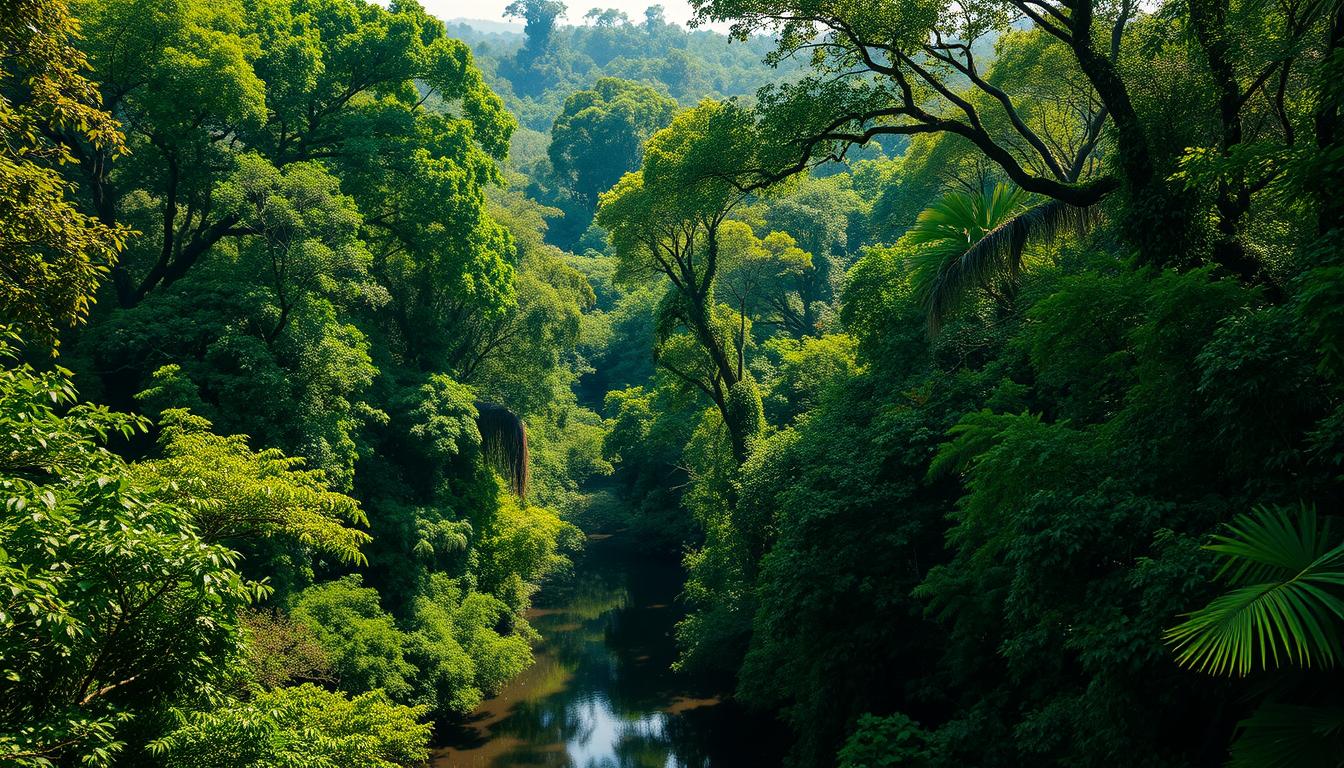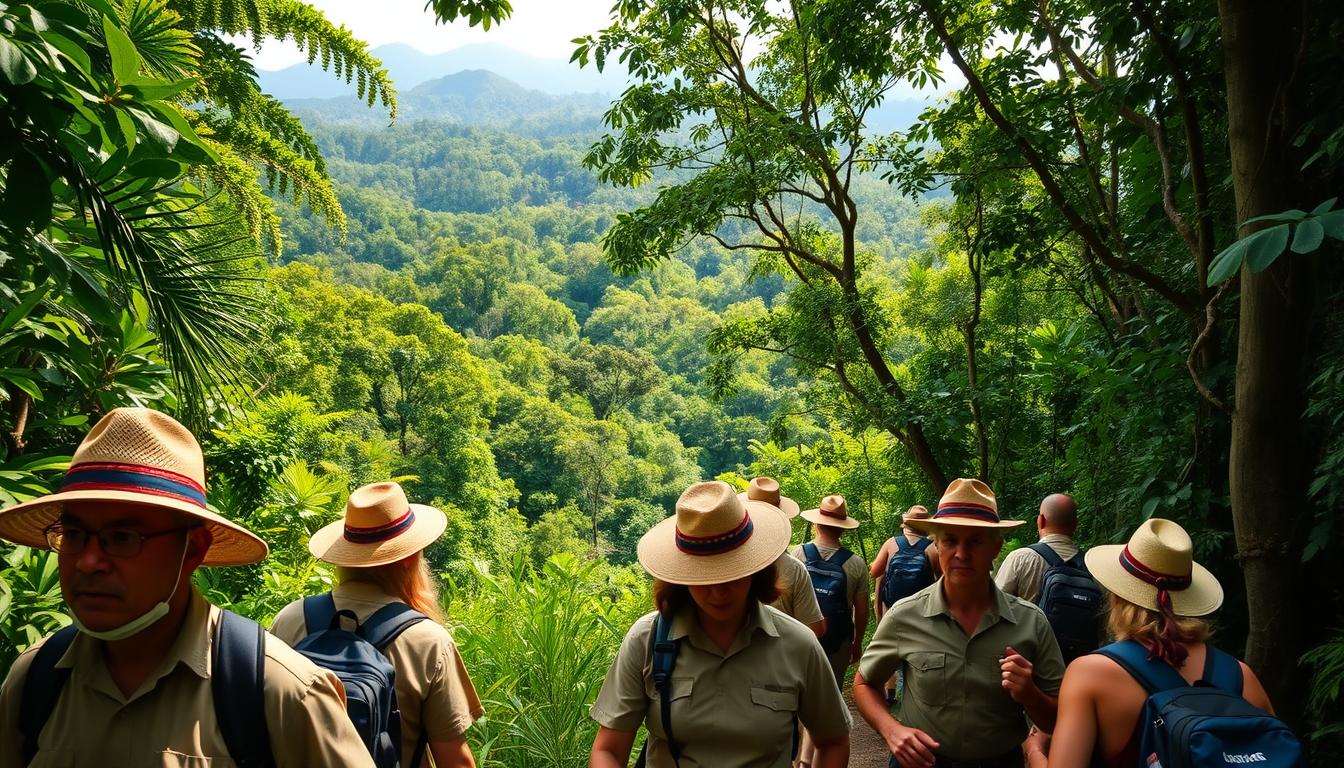The Amazon rainforest, often referred to as the “lungs of the Earth,” is facing unprecedented dangers. Logging and fires have become rampant, threatening the very existence of this vital ecosystem.
The destruction of the Amazon rainforest not only affects the environment but also has far-reaching consequences for the global climate. As we witness the devastating impact of human activities on the Amazon, there is still hope for its preservation. Efforts to conserve this precious resource are underway, driven by communities, organizations, and governments working together.
Key Takeaways
- The Amazon rainforest is crucial for the global ecosystem.
- Logging and fires are major contributors to Amazon destruction.
- Conservation efforts are underway to protect the Amazon.
- Global cooperation is essential for preserving the Amazon.
- Hope for the Amazon’s preservation lies in collective action.
The Amazon Rainforest: Earth’s Vital Organ
As the world’s largest tropical rainforest, the Amazon plays a vital role in maintaining global biodiversity. The Amazon rainforest is not just a collection of trees; it’s a complex ecosystem that supports an immense array of plant and animal life.

The Amazon’s Global Significance
The Amazon is often referred to as the “lungs of the Earth” due to its immense oxygen production. It produces about 20% of the world’s oxygen, making it crucial for life on Earth. The Amazon’s global significance extends beyond its ecological importance, as it also supports the livelihoods of millions of people, including indigenous communities.
A quote from a renowned environmentalist highlights the Amazon’s importance:
“The Amazon rainforest is a precious resource that needs to be protected for future generations.”
Key Statistics and Facts
The Amazon rainforest covers an area of over 5.5 million square kilometers, spanning across nine countries in South America. It is home to more than 40,000 plant species and 1,300 bird species. The Amazon is also a significant carbon sink, absorbing and storing vast amounts of carbon dioxide.
- 40,000+ plant species
- 1,300+ bird species
- 5.5 million square kilometers in size
Ecological Services Provided
The Amazon provides numerous ecological services, including supporting biodiversity, regulating the climate, and maintaining the water cycle. The rainforest’s ecological services are essential for maintaining the health of our planet. However, deforestation in the amazon and biodiversity loss amazon are significant concerns that need to be addressed to preserve the Amazon’s ecological integrity.
Understanding Deforestation in the Amazon
Understanding the complexities of deforestation in the Amazon is crucial for developing effective conservation strategies. The Amazon rainforest, a vital component of the Earth’s ecosystem, has been facing severe threats from deforestation, driven by a combination of historical and contemporary factors.
Historical Context of Amazon Deforestation
The history of deforestation in the Amazon dates back to the colonial era, but it wasn’t until the 20th century that large-scale deforestation began. The construction of the Trans-Amazonian Highway in the 1970s opened up the region to settlers and marked the beginning of widespread forest clearance for agriculture and livestock.
Current Deforestation Rates and Trends
In recent years, deforestation rates in the Amazon have seen a concerning increase. According to data from the National Institute for Space Research (INPE), the Amazon experienced significant forest loss, driven by agricultural expansion, infrastructure development, and illegal logging.

Primary Drivers of Forest Loss
The main drivers of deforestation in the Amazon are complex and interrelated. They include:
Agricultural Expansion
The expansion of agricultural land for soybeans, cattle, and other crops is a major driver of deforestation. Large-scale farming operations clear vast areas of forest, leading to habitat loss and increased greenhouse gas emissions.
Infrastructure Development
The construction of roads, dams, and other infrastructure projects fragments habitats and facilitates access to previously untouched areas of the forest, leading to further deforestation.
Economic Pressures
Economic pressures, including the demand for timber and agricultural products, drive deforestation. Illegal logging and land speculation also contribute to forest loss.
| Driver | Impact | Examples |
|---|---|---|
| Agricultural Expansion | Habitat loss, increased emissions | Soybean farming, cattle ranching |
| Infrastructure Development | Habitat fragmentation, increased access | Road construction, dam building |
| Economic Pressures | Illegal logging, land speculation | Timber extraction, land grabbing |
By understanding these drivers, we can begin to develop targeted strategies to mitigate deforestation and protect the Amazon rainforest.
Threats to the Amazon: Logging, Fires, and Hope
As the Amazon rainforest teeters on the brink of disaster, understanding the threats it faces is crucial. The Amazon is confronted with numerous dangers, including rampant logging and devastating forest fires, which are often interconnected and exacerbated by political and economic factors.
Overview of Major Threats
The Amazon faces significant threats from logging and forest fires, which are major contributors to deforestation. Illegal logging, in particular, poses a severe risk as it not only harms the forest ecosystem but also undermines legal forestry practices.

Interconnection Between Different Threats
The threats to the Amazon are not isolated; they are interconnected in complex ways. For instance, logging can make forests more susceptible to fires by creating dry conditions and providing ignition sources. Conversely, fires can facilitate further logging by damaging trees and making them easier to harvest.
“The Amazon is a complex ecosystem where the impact of one threat can cascade into others, creating a vicious cycle of destruction.”
Timeline of Escalating Dangers
The dangers facing the Amazon have escalated over time, with recent years seeing a significant acceleration in deforestation rates.
Recent Acceleration of Destruction
Recent political and economic changes have led to an increase in both legal and illegal activities that harm the Amazon, such as relaxed environmental regulations and increased agricultural expansion.
Political and Economic Factors
Political decisions, such as changes in land use policies, and economic incentives, like those driving agricultural expansion, play a significant role in the rate of deforestation. Understanding these factors is key to mitigating the threats to the Amazon.
The Logging Crisis
The logging crisis in the Amazon is a complex issue driven by various economic and environmental factors. As the world’s demand for timber continues to grow, the Amazon rainforest, with its vast array of tree species, becomes an increasingly attractive target for logging operations.
Economic Drivers of Logging
Economic factors play a significant role in driving the logging crisis in the Amazon. The high demand for timber and timber products, such as mahogany and teak, fuels both legal and illegal logging operations. The lucrative nature of the timber industry, coupled with inadequate law enforcement and corruption, exacerbates the problem.
According to a report, “The global timber trade is worth billions of dollars, with a significant portion coming from the Amazon rainforest.” This highlights the scale of the economic drivers behind the logging crisis.
Legal vs. Illegal Logging Operations
The distinction between legal and illegal logging is crucial in understanding the logging crisis. While legal logging is regulated and supposed to be sustainable, illegal logging operations often disregard environmental and social regulations, causing more harm.
- Legal logging is supposed to follow sustainable forestry practices.
- Illegal logging disregards regulations, causing environmental degradation.
Impact on Forest Structure and Health
Logging, whether legal or illegal, has a significant impact on the forest structure and health. The removal of trees not only affects the immediate area but also has broader ecological consequences.
Selective Logging Consequences
Selective logging, where only certain valuable trees are removed, might seem less harmful but still causes significant damage. It can lead to:
- Soil erosion due to the removal of tree cover.
- Increased vulnerability to fires.

Clear-cutting, on the other hand, is even more devastating. It involves the removal of all trees in a given area, leading to:
- Loss of biodiversity.
- Disruption of local ecosystems.
“The Amazon rainforest is not just a collection of trees; it’s a complex ecosystem that supports life on Earth. The logging crisis threatens this delicate balance.”
The logging crisis in the Amazon is a pressing issue that requires immediate attention. Understanding its complexities, from economic drivers to environmental impacts, is crucial in finding sustainable solutions.
Amazon Fires: Causes and Consequences
Fires in the Amazon have escalated to alarming levels, posing significant threats to the world’s largest tropical rainforest. The complexity of this issue necessitates a comprehensive understanding of its causes and consequences.
Natural vs. Human-Caused Fires
Amazon fires can be categorized into natural and human-caused fires. While natural fires are relatively rare and often caused by lightning, human-caused fires are predominantly linked to agricultural practices and land management activities. Human activities are responsible for the majority of Amazon fires, with farmers using fire as a tool for clearing land for agriculture and pasture.
The distinction between natural and human-caused fires is crucial for developing effective mitigation strategies. Understanding the root causes of these fires can help policymakers and conservationists target their efforts more effectively.
Recent Fire Seasons and Their Severity
In recent years, the Amazon has experienced some of its most severe fire seasons. The 2019 Amazon rainforest wildfires were particularly devastating, drawing international attention to the plight of the Amazon. These fires not only destroyed vast areas of forest but also had significant implications for global climate change.

The severity of these fire seasons is often exacerbated by drought conditions, which are becoming more frequent due to climate change. This creates a vicious cycle where climate change contributes to the conditions that lead to more severe fires, which in turn exacerbate climate change.
Long-term Effects of Repeated Burning
Repeated burning of the Amazon rainforest has long-term effects on the ecosystem, including soil degradation and challenges to forest recovery.
Soil Degradation
Soil degradation is a significant consequence of repeated burning. The loss of vegetation cover exposes the soil to erosion, and the heat from fires can alter soil composition, making it less fertile. This degradation can have lasting impacts on the forest’s ability to recover.
Forest Recovery Challenges
Forest recovery after repeated burning is challenging due to the changed environmental conditions. The loss of seed sources, altered soil chemistry, and increased vulnerability to invasive species can hinder the natural regeneration process. Efforts to restore degraded forests are crucial for maintaining biodiversity and ecosystem services.
Understanding the causes and consequences of Amazon fires is essential for developing effective conservation strategies. By addressing the root causes of these fires and supporting efforts to restore degraded forests, we can work towards preserving the Amazon rainforest for future generations.
Climate Change and the Amazon
Climate change poses a significant danger to the Amazon, impacting its ability to function as a vital carbon sink. The Amazon rainforest plays a crucial role in regulating the global climate, and its degradation can have far-reaching consequences.
The Amazon as Carbon Sink
The Amazon rainforest is one of the world’s most significant carbon sinks, absorbing and storing massive amounts of carbon dioxide. However, climate change is threatening this capacity. Rising temperatures and altered precipitation patterns can lead to increased tree mortality and reduced photosynthesis, undermining the forest’s ability to act as a carbon sink.
Feedback Loops Between Deforestation and Climate
There’s a dangerous feedback loop between deforestation and climate change. When the Amazon is deforested, not only is carbon released into the atmosphere, but the forest’s ability to regulate the climate is also diminished. This can lead to further climate change, which in turn can cause more deforestation, creating a vicious cycle.
Projected Climate Impacts on Forest Health
The health of the Amazon rainforest is expected to be severely impacted by projected climate changes. Two critical areas of concern are drought vulnerability and changing rainfall patterns.
Drought Vulnerability
Increased frequency and severity of droughts can have devastating effects on the Amazon. Droughts can lead to increased tree mortality, reduced forest regeneration, and heightened susceptibility to fires.
Changing Rainfall Patterns
Changes in rainfall patterns can disrupt the delicate balance of the Amazon ecosystem. Some areas may experience more frequent and intense flooding, while others may suffer from prolonged droughts. This variability can have significant impacts on forest health and biodiversity.
| Climate Impact | Effect on Amazon |
|---|---|
| Increased Droughts | Higher tree mortality, increased fire risk |
| Changing Rainfall | Disrupted ecosystem balance, biodiversity loss |
| Rising Temperatures | Reduced carbon sequestration, increased stress on forest |
Indigenous Communities: Guardians of the Forest
Indigenous communities are the unsung heroes of the Amazon, maintaining the forest’s health through time-honored practices. For centuries, they have lived in harmony with the rainforest, developing a deep understanding of its ecosystem.
Traditional Stewardship of the Amazon
Indigenous communities have traditionally managed the Amazon through practices that ensure the long-term health of the forest. This includes rotational farming, selective logging, and the use of forest products in a sustainable manner.
Threats to Indigenous Rights and Lands
Despite their crucial role in conservation, indigenous communities face numerous threats, including encroachment by loggers, miners, and agricultural companies. These activities not only destroy the forest but also undermine the rights of indigenous peoples to their lands.
Success Stories of Indigenous Conservation
There are many success stories of indigenous conservation efforts in the Amazon. These include the establishment of protected areas and the development of sustainable forest management plans.
Effective Land Management Practices
Indigenous communities have developed effective land management practices that maintain the forest’s biodiversity. These practices are often based on traditional knowledge passed down through generations.
Cultural Knowledge and Biodiversity
The cultural knowledge of indigenous communities is closely linked to the biodiversity of the Amazon. Their understanding of the forest ecosystem is invaluable in conservation efforts.
| Conservation Method | Description | Impact |
|---|---|---|
| Rotational Farming | Crops are rotated to maintain soil fertility and reduce pests. | Maintains soil health and reduces the need for chemical fertilizers. |
| Selective Logging | Only certain tree species are harvested, leaving others intact. | Preserves forest structure and maintains biodiversity. |
| Sustainable Forest Products | Products are harvested in a way that does not harm the forest. | Provides income for indigenous communities without degrading the forest. |
Hope for the Amazon: Conservation and Sustainable Solutions
Despite the numerous threats facing the Amazon, there is a growing sense of hope driven by innovative conservation efforts. The Amazon’s preservation is now more feasible than ever, thanks to a combination of global support, local action, and technological advancements.
Global Conservation Initiatives
International cooperation is playing a crucial role in Amazon conservation. Organizations and governments worldwide are coming together to support initiatives aimed at protecting the rainforest. One notable example is the Amazon Fund, which has garnered significant international support to combat deforestation.
Sustainable Economic Alternatives
Promoting sustainable economic alternatives is vital for the Amazon’s future. Eco-tourism and sustainable forest products are emerging as viable options that can support local economies while preserving the forest. These alternatives not only provide income but also incentivize the conservation of the Amazon’s natural resources.
Technological Innovations for Protection
Technology is revolutionizing Amazon conservation. From satellite monitoring systems to community-based conservation models, innovative solutions are being implemented to protect the rainforest.
Satellite Monitoring Systems
Satellite technology allows for real-time monitoring of the Amazon, enabling quick responses to illegal activities such as logging and land clearing. Organizations like the Amazon Conservation Association (ACA) are leveraging satellite data to protect the forest.
Reforestation and Restoration Projects
Reforestation and restoration efforts are underway to revive degraded areas of the Amazon. These projects not only help in regaining lost biodiversity but also contribute to climate change mitigation by sequestering carbon.
Community-Based Conservation Models
Indigenous and local communities are at the forefront of Amazon conservation. Community-based models empower these communities to manage their lands sustainably, preserving traditional knowledge while adopting modern conservation practices.
| Conservation Method | Description | Impact |
|---|---|---|
| Satellite Monitoring | Real-time surveillance of the Amazon | Quick response to illegal activities |
| Reforestation | Restoration of degraded forest areas | Biodiversity recovery and carbon sequestration |
| Community-Based Conservation | Empowering local communities to manage their lands | Preservation of traditional knowledge and sustainable practices |
Conclusion: The Path Forward for Amazon Preservation
The Amazon rainforest is at a critical juncture, facing unprecedented threats from logging, fires, and climate change. Despite these challenges, there is hope for its preservation through concerted amazon conservation efforts and the adoption of sustainable practices.
Throughout this article, we’ve explored the major threats to the Amazon, including the devastating impact of logging and fires, as well as the critical role of indigenous communities in forest stewardship. We’ve also discussed the importance of international conservation initiatives and sustainable economic alternatives in mitigating the environmental impact of human activities on the Amazon.
Moving forward, it is essential to continue supporting sustainable practices and conservation initiatives that protect the Amazon and its biodiversity. By doing so, we can help prevent biodiversity loss and ensure the long-term preservation of this vital ecosystem. The path forward requires a collaborative effort from governments, organizations, and individuals to safeguard the Amazon’s future.




